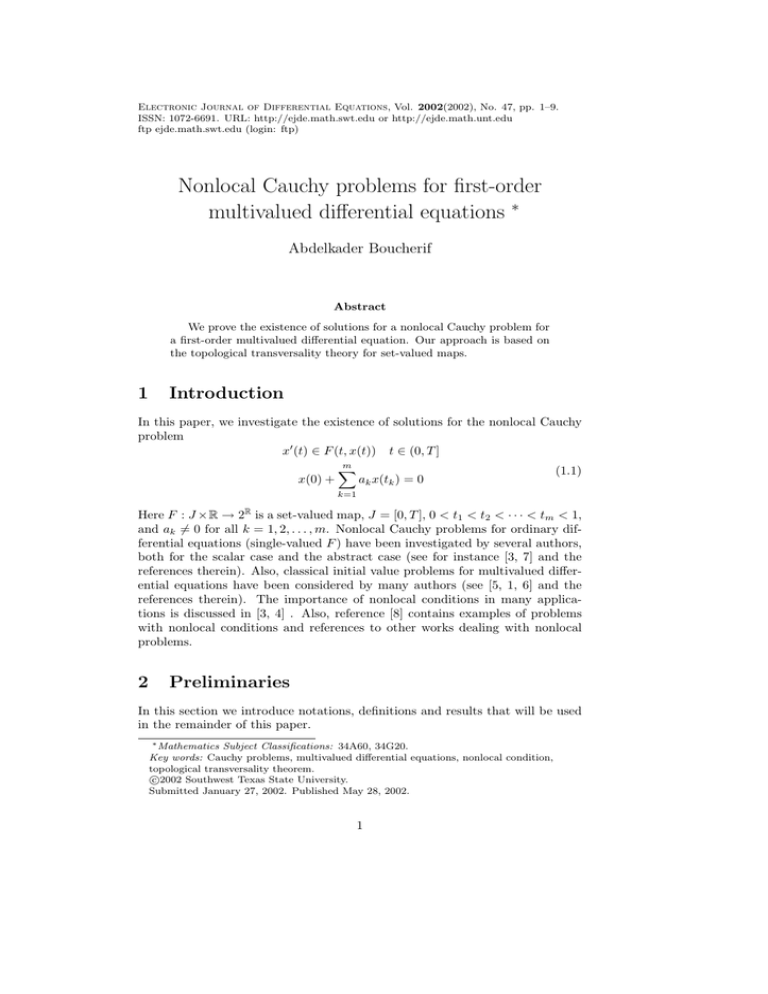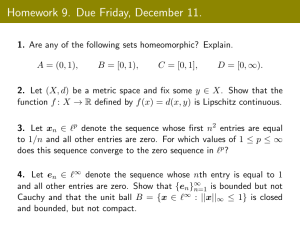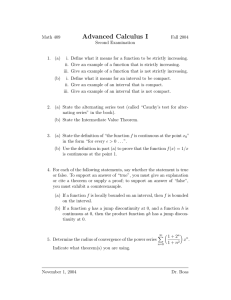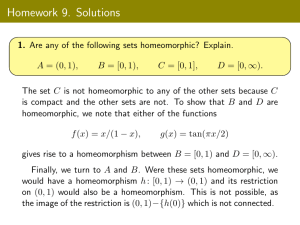Document 10749159
advertisement

Electronic Journal of Differential Equations, Vol. 2002(2002), No. 47, pp. 1–9.
ISSN: 1072-6691. URL: http://ejde.math.swt.edu or http://ejde.math.unt.edu
ftp ejde.math.swt.edu (login: ftp)
Nonlocal Cauchy problems for first-order
multivalued differential equations ∗
Abdelkader Boucherif
Abstract
We prove the existence of solutions for a nonlocal Cauchy problem for
a first-order multivalued differential equation. Our approach is based on
the topological transversality theory for set-valued maps.
1
Introduction
In this paper, we investigate the existence of solutions for the nonlocal Cauchy
problem
x0 (t) ∈ F (t, x(t)) t ∈ (0, T ]
m
X
(1.1)
x(0) +
ak x(tk ) = 0
k=1
Here F : J ×R → 2 is a set-valued map, J = [0, T ], 0 < t1 < t2 < · · · < tm < 1,
and ak 6= 0 for all k = 1, 2, . . . , m. Nonlocal Cauchy problems for ordinary differential equations (single-valued F ) have been investigated by several authors,
both for the scalar case and the abstract case (see for instance [3, 7] and the
references therein). Also, classical initial value problems for multivalued differential equations have been considered by many authors (see [5, 1, 6] and the
references therein). The importance of nonlocal conditions in many applications is discussed in [3, 4] . Also, reference [8] contains examples of problems
with nonlocal conditions and references to other works dealing with nonlocal
problems.
R
2
Preliminaries
In this section we introduce notations, definitions and results that will be used
in the remainder of this paper.
∗ Mathematics Subject Classifications: 34A60, 34G20.
Key words: Cauchy problems, multivalued differential equations, nonlocal condition,
topological transversality theorem.
c
2002
Southwest Texas State University.
Submitted January 27, 2002. Published May 28, 2002.
1
2
Nonlocal Cauchy problems
EJDE–2002/47
Function spaces
Let J be a compact interval in R. C(J) is the Banach space of continuous
real-valued functions defined on J, with the norm kxk0 = sup{|x(t)|; t ∈ J}
for x ∈ C(J). C k (J) is the Banach space of k-times continuously Rdifferentiable
functions. Lp (J) is the set of measurable functions x such that J |x(t)|p dt <
R
+∞. Define kxkLp = ( J |x(t)|p dt)1/p . The Sobolev spaces W k,p (J) are defined
as follows:
Z
Z
n
1,p
p
0
p
0
W (J) :=
x ∈ L (J); ∃ x ∈ L (J) such that
xφ = − x0 φ
J
o J
1
∀φ ∈ C (J) with compact support
or equivalently,
W 1,p (J) = {x : J → R; x absolutely continuous and x0 ∈ Lp (J), 1 ≤ p ≤ ∞} .
Then we define
W k,p (J) = x ∈ W k−1,p (J); x0 ∈ W k−1,p (J)
k ≥ 2.
The notation H 1 (J) is used for W 1,2 (J). Let
Hb1 (J) := {u ∈ H 1 (J); u(0) +
m
X
ak u(tk ) = 0}.
k=1
Note that the embeddings j : W k,p (J) → C k−1 (J), p > 1, are completely
continuous for J compact [2].
Set-valued Maps
Let X and Y be Banach spaces. A set-valued map G : X → 2Y is said to be
compact if G(X) = ∪{G(x); x ∈ X} is compact. G has convex (closed, compact)
values if G(x) is convex (closed, compact) for every x ∈ X. G is bounded on
bounded subsets of X if G(B) is bounded in Y for every bounded subsets B of
X. A set-valued map G is upper semicontinuous at z0 ∈ X if for every open set
O containing Gz0 , there exists a neighborhood M of z0 such that G(M) ⊂ O.
G is upper semicontinuous on X if it is upper semicontinuous at every point
of X. If G is nonempty and compact-valued then G is upper semicontinuous
if and only if G has a closed graph. The set of all bounded closed convex and
nonempty subsets of X is denoted by bcc(X). A set-valued map G : J → bcc(X)
is measurable if for each x ∈ X, the function t 7→ dist(x, G(t)) is measurable on
J. If X ⊂ Y , G has a fixed point if there exists x ∈ X such that x ∈ Gx. Also,
|G(x)| = sup{|y|; y ∈ G(x)}.
EJDE–2002/47
Definition
if
Abdelkader Boucherif
3
A multivalued map F : J × R → 2R is said to be L1 -Carathéodory
(i) t 7→ F (t, y) is measurable for each y ∈ R;
(ii) y 7→ F (t, y) is upper semicontinuous for almost all t ∈ J;
(iii) For each σ > 0, there exists hσ ∈ L1 (J, R+ ) such that
kF (t, y)k = sup{|v| : v ∈ F (t, y)} ≤ hσ (t)
for all |y| ≤ σ and for almost all t ∈ J.
The set of selectors of F that belong to L1 is denoted by
SF1 (.,y(.)) = {v ∈ L1 (J, ) : v(t) ∈ F (t, y(t)) for a.e. t ∈ J}
By a solution of (1.1) we mean an absolutely continuous function x on J, such
that x0 ∈ L1 and
x0 (t) = f (t) a.e. t ∈ (0, T ]
m
X
(2.1)
x(0) +
ak x(tk ) = 0
k=1
where f ∈ SF1 (.,x(.)) .
Note that for an L1 -Carathéodory multifunction F : J × R → 2R the set
1
SF (.,x(.)) is not empty (see [9]). For more details on set-valued maps we refer to
[5].
Topological Transversality Theory for Set-valued Maps
Let X be a Banach space, C a convex subset of X and U an open subset of
C. K∂U (U , 2C ) shall denote the set of all set-valued maps G : U → 2C which
are compact, upper semicontinuous with closed convex values and have no fixed
points on ∂U (i.e., u ∈
/ Gu for all u ∈ ∂U ). A compact homotopy is a set-valued
map H : [0, 1] × U → 2C which is compact, upper semicontinuous with closed
convex values. If u ∈
/ H(λ, u) for every λ ∈ [0, 1], u ∈ ∂U , H is said to be fixed
point free on ∂U . Two set-valued maps F, G ∈ K∂U (U , 2C ) are called homotopic
in K∂U (U , 2C ) if there exists a compact homotopy H : [0, 1] × U → 2C which
is fixed point free on ∂U and such that H(0, ·) = F and H(1, ·) = G. G ∈
K∂U (U , 2C ) is called essential if every F ∈ K∂U (U , 2C ) such that G|∂U = F |∂U ,
has a fixed point. Otherwise G is called inessential. For more details we refer
the reader to [6].
Theorem 2.1 (Topological transversality theorem) Let F, G be two homotopic set-valued maps in K∂U (U , 2C ). Then F is essential if and only if G
is essential.
Theorem 2.2 Let G : U → 2C be the constant set-valued map G(u) ≡ u0 .
Then, if u0 ∈ U , G is essential
4
Nonlocal Cauchy problems
EJDE–2002/47
Theorem 2.3 (Nonlinear Alternative) Let U be an open subset of a convex
set C, with 0 ∈ U . Let H : [0, 1] × U → 2C be a compact homotopy such that
H0 ≡ 0. Then, either
(i) H(1, ·) has a fixed point in U , or
(ii) there exists u ∈ ∂U and λ ∈ (0, 1) such that u ∈ H(λ, u).
3
Main results
To prove our main results, we assume the following:
(H0) ak 6= 0 for each k = 1, 2, . . . , m and
Pm
k=1
ak + 1 6= 0.
(H1) F : J × R → bcc(R), (t, x) 7→ F (t, x) is
(i) measurable in t, for each x ∈ R
(ii) upper semicontinuous with respect to x ∈ for a.e. t ∈ J
(H2) |F (t, x)| ≤ ψ(|x|) for a.e. t ∈ J, all x ∈ R, where ψ : [0, +∞) → (0, +∞)
is continuous nondecreasing and such that lim supρ→∞ ψ(ρ)
ρ = 0.
Our first result reads as follows.
Theorem 3.1 If the assumptions (H0), (H1), and (H2) are satisfied, then the
initial-value problem (1.1) has at least one solution.
Proof This proof will be given in several steps, and uses some ideas from [6].
Step 1. Consider the set-valued operator Φ : C(J) → L2 (J) defined as
(Φx)(t) = F (t, x(t)).
Note that Φ is well defined, upper semicontinuous, with convex values and sends
bounded subsets of C(J) into bounded subsets of L2 (J). In fact, we have
Φx := {u : J → R
measurable; u(t) ∈ F (t, x(t)) a.e. t ∈ J} .
Let z ∈ C(J). If u ∈ Φz then
|u(t)| ≤ ψ(|z(t)|) ≤ ψ(kzk0 ).
Hence kukL2 ≤ C0 := ψ(kzk0 ). This shows that Φ is well defined. It is clear
that Φ is convex valued.
Now, let B be a bounded subset of C(J). Then, there exists K > 0 such that
kuk0 ≤ K for u ∈ B. So, for w ∈ Φu we have kwkL2 ≤ C1 , where C1 = ψ(K).
Also, we can argue as in [5, p. 16] to show that Φ is upper semicontinuous.
EJDE–2002/47
Abdelkader Boucherif
5
Step 2. Let x be a possible solution of (1.1). Then there exists a positive
constant R∗ , not depending on x, such that
|x(t)| ≤ R∗
for all t in J.
It follows from the definition of solutions of (1.1) that
x0 (t) = f (t) a.e. t ∈ (0, T ]
m
X
x(0) +
ak x(tk ) = 0
(3.1)
k=1
where f ∈ SF1 (.,x(.)) . Simple computations give
m
X
x(t) = 1 +
ak
k=1
−1
−
m
X
ak
tk
Z
f (s)ds +
0
k=1
t
Z
f (s)ds
(3.2)
0
Hence
Z
m
m
X
−1 X
|ak |
|x(t)| ≤ 1 +
ak
k=1
tk
|f (s)|ds +
0
k=1
Z
t
|f (s)|ds
0
Assumption (H2) yields
Z
m
m
X
−1 X
|ak |
ak
|x(t)| ≤ 1 +
k=1
k=1
tk
0
ψ(|x(s)|)ds +
Z
t
ψ(|x(s)|)ds
0
Let
R0 = max {|x(t)|; t ∈ J} .
Then
m
m
X
−1 X
|ak | tk ψ(R0 ) + T ψ(R0 )
ak
R0 ≤ 1 +
k=1
or
R0 ≤
k=1
m
m
i
h
X
−1 X
1+
|ak | tk + T ψ(R0 )
ak
k=1
k=1
The above inequality implies
m
m
ψ(R )
X
X
0
ak )−1 |ak | tk
1 ≤ T + (1 +
R0
k=1
k=1
Now, the condition on ψ in (H2) shows that there exists R∗ > 0 such that for
all R > R∗ ,
m
m
ψ(R)
X
X
T + (1 +
ak )−1 |ak | tk
< 1.
R
k=1
k=1
6
Nonlocal Cauchy problems
EJDE–2002/47
Comparing these last two inequalities, we see that R0 ≤ R∗ . Consequently, we
obtain |x(t)| ≤ R∗ for all t ∈ J.
Step 3. For 0 ≤ λ ≤ 1 consider the one-parameter family of problems
x0 (t) ∈ λF (t, x(t)) t ∈ J,
m
X
x(0) +
ak x(tk ) = 0.
(3.3)
k=1
It follows from Step 2 that if x is a solution of (3.3) for some λ ∈ [0, 1], then
|x(t)| ≤ R∗
for all t ∈ J
and R∗ does not depend on λ. Define Φλ : C(J) → L2 (J) as
(Φλ x)(t) = λF (t, x(t)).
Step 1 shows that Φλ is upper semicontinuous, has convex values and sends
bounded subsets of C(J) into bounded subsets of L2 (J). Let j : Hb1 (J) → C(J)
be the completely continuous embedding. The operator L : Hb1 (J) → L2 (J),
defined by (Lx)(t) = x0 (t) has a bounded inverse (in fact this follows from the
solution of (3.1) which is given by (3.2)), which we denote by L−1 . Let BR∗ +1 :=
{x ∈ C(J); kxk0 < R∗ + 1}. Define a set-valued map H : [0, 1] × BR∗ +1 → C(J)
by
H(λ, x) = (j ◦ L−1 ◦ Φλ )(x).
We can easily show that the fixed points of H(λ, ·) are solutions of (3.3). Moreover, H is a compact homotopy between H(0, ·) ≡ 0 and H(1, ·). In fact, H is
compact since Φλ is bounded on bounded subsets and j is completely continuous. Also, H is upper semicontinuous with closed convex values. Since solutions
of (1)λ satisfy kxk0 ≤ R∗ < R∗ + 1 we see that H(λ, ·) has no fixed points on
∂BR∗ +1 .
Now, H(0, ·) is essential by Theorem 2. Hence H1 is essential. This implies
that j ◦ L−1 ◦ Φ has a fixed point. Therefore problem (1.1) has a solution . This
completes the proof of Theorem 3.1.
Our next result is based on an application of the nonlinear alternative. We
shall replace condition (H2) by
(H2’) |F (t, x)| ≤ p(t)ψ(|x|) for a.e. t ∈ J, all x ∈ R, where p ∈ L1 (J, R+ ),
ψ : [0, +∞) → (0, +∞) is continuous nondecreasing and such that
sup
δ∈(0,∞) [{|(1 +
Pm
−1 |
k=1 ak )
δ
Pm
k=1
|ak | } + T ] kpkL1 ψ(δ)
>1
Now, we state our second result.
Theorem 3.2 If assumptions (H0), (H1), and (H2’) are satisfied, then the
initial value problem (1.1) has at least one solution.
EJDE–2002/47
Abdelkader Boucherif
7
Proof This proof is similar to the proof of Theorem 3.1. Let M0 > 0 be
defined by
M0
[{|(1 +
Pm
k=1
ak
)−1 |
Pm
k=1
|ak |
R tk
0
p(s)ds} + kpkL1 ]ψ(M0 )
> 1.
Let U := {x ∈ C(J); kxk0 < M0 }. Then consider the compact homotopy (see
Step 3 above) H : [0, 1] × U → C(J) defined by
H(λ, x) = (j ◦ L−1 ◦ Φλ )(x).
Suppose that alternative (ii) in Theorem 2.3 holds. This means that there exist
u ∈ ∂U and λ ∈ (0, 1) such that u ∈ H(λ, u), or equivalently
u0 (t) ∈ λF (t, u(t)) t ∈ J,
m
X
u(0) +
ak u(tk ) = 0
k=1
Now, as in Step2 above, assumption (H2’) yields
Z
m
m
X
−1 X
|u(t)| ≤ 1 +
ak
|ak |
k=1
tk
p(s)ψ(|u(s)|)ds +
0
k=1
t
Z
p(s)ψ(|u(s)|)ds
0
Since ψ is increasing,
Z
m
m
X
−1 X
|u(t)| ≤ 1 +
ak
|ak |
k=1
tk
p(s)ψ(kuk0 )ds +
0
k=1
t
Z
p(s)ψ(kuk0 )ds .
0
Since for u ∈ ∂U we have kuk0 = M0 this last inequality implies that
Z
m
m
X
−1 X
|ak |
M0 ≤ 1 +
ak
0
k=1
k=1
tk
p(s)ψ(M0 )ds +
Z
t
p(s)ψ(M0 )ds
0
which, in turn gives
M0 ≤
Z
m
m
hn
X
−1 X
1+
ak
|ak |
k=1
k=1
tk
0
o Z t
i
p(s)ds +
p(s)ds ψ(M0 )
0
Hence,
M0 ≤
Z
m
m
hn
X
−1 X
1+
ak
|ak |
k=1
k=1
0
tk
o
i
p(s)ds + kpkL1 ψ(M0 )
This, clearly, contradicts the definition of M0 . Therefore, condition (ii) of Theorem 2.3 does not hold. Consequently, H(1, .) has a fixed point, which is a
solution of problem (1.1).
8
Nonlocal Cauchy problems
EJDE–2002/47
Pm
Remark For nonlocal initial values of the form x(0) + k=1 akP
x(tk ) = x0 ,
m
where x0 is a given nonzero real number, we let y(t) = x(t)−x0 (1+ k=1 ak )−1 .
Then y is a solution to the problem
y 0 (t) ∈ F (t, y(t) + x0 (1 +
m
X
ak )−1 )
k=1
y(0) +
m
X
ak y(tk ) = 0
k=1
Acknowledgement The author wishes to thank KFUPM for its constant
support.
References
[1] M. Benchohra and A. Boucherif, On first order multivalued initial and periodic value problems, Dynamic Syst.Appl. Vol. 9 (2000), 559-568.
[2] H. Brezis, Analyse Fonctionnelle et Applications, Masson, Paris, 1983.
[3] L. Byszewski, Theorems about the existence and uniqueness of solutions of
a semilinear evolution nonlocal Cauchy problem, J. Math. Anal. Appl. 162
(1991), 494-505.
[4] L. Byszewski, Abstract nonlinear nonlocal problems and their physical interpretation, in “ Biomathematics, Bioinformatics and Applications of Functional Differential Difference Equations”, H.Akca, V.Covachev and E. Litsyn, Eds., Akdeniz Univ. Publ., Antalya, Turkey, 1999
[5] K. Deimling, Multivalued Differential Equations, W. de Gruyter, Berlin,
1992.
[6] M. Frigon, Application de la transversalite topologique a des problemes non
lineaires pour des equations differentielles ordinaires, Dissertationes Math.
296 PWN, Warszava, 1990.
[7] H-K. Han and J-Y. Park, Boundary controllability of differential equations
with nonlocal conditions, J. Math. Anal. Appl. 230 (1999), 242-250.
[8] D. Jackson, Existence and uniqueness of solutions to semilinear nonlocal
parabolic equations, J. Math. Anal. Appl. Vol. 172 (1993), 256-265.
[9] A. Lasota and Z. Opial, An application of the Kakutani-Ky-Fan theorem in
the theory of ordinary differential equations, Bull. Acad. Polon. Sci. Ser. Sci.
Math. Astronom. Phys. 13 (1965), 781-786.
EJDE–2002/47
Abdelkader Boucherif
Abdelkader Boucherif
King Fahd University of Petroleum and Minerals
Department of Mathematical Sciences
P.O. Box 5046 Dhahran 31261, Saudi Arabia
e-mail: aboucher@kfupm.edu.sa
9







